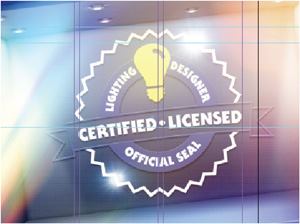LIGHTING DESIGN EDUCATION The relative infancy of lighting design has made its education difficult. Several noteworthy programs exist, but only one—Parsons—grants a degree in lighting design. The rest include it in some more encompassing degree, such as architecture, engineering, or theater.
This means that we cannot define what exactly constitutes lighting design knowledge or skill. The extreme diversity of opinion and curriculum suggests that agreement upon a common core will be hard to achieve.
For years, the Illuminating Engineering Society (IES) has struggled with this issue. The IES has done an excellent job of being a center for technical knowledge collection and dissemination. But the IES has consistently been unable to involve designers, artisans, and related professionals who design lighting on an aesthetic or intuitive level. A constant tension of “designer versus engineer” has prevailed.
By charter, the IES cannot pursue professional issues such as licensing. If it did, it would no longer be a technical society accredited to write ANSI standards. To fill the gap, the International Association of Lighting Designers (IALD), a relatively new organization, serves the lighting design community. The IALD appears to be to lighting designers what the ASID has been to interior designers. The IALD uniquely understands the professional practice issues of lighting design. It currently certifies lighting designers by portfolio review.
The polarity of the IES and the IALD has terrific side benefits. They form other joint committees and provide common support for certain of each other’s causes.
CERTIFY FIRST Certification is the natural first step in the process of gaining professional recognition for lighting design as more than a commodity. If knowledgeable clients can at least demand professional membership in a certifying group similar to ASID, then a standard exists against which to measure progress and to judge qualification criteria.
The work being done by the IES and the IALD committees in this area is very timely. Of course, agreeing upon testing topics, skills, and the like will be a problem. The secret of success, as NCIDQ has demonstrated, is to establish an independent third-party testing and certification authority whose test results will be accepted by both organizations. The testing standards defined by the third party will establish the required knowledge and skills, in turn helping to define academic curricula and, ultimately, accreditation of schools and colleges.
The IALD has established professional ethics that prevent members from holding any vested interest in the products they specify. The public deserves to know that an IALD member is honestly independent, earning fees by the hour. The IES could easily accommodate its members who work for manufacturers, distributors, agencies, and so forth by establishing a premier membership grade for independent certified professionals.
PITFALLS OF LICENSING The need to avoid licensing—at least for now—is as obvious as the need for a good certification program. Too many engineers, architects, interior designers, and other licensable professionals could rightfully argue that lighting design is part of their current practice, and that their personal skill and knowledge level is competent.
The battle over title and practice protection can be brutally emotional. Architects and the AIA have fought progress toward licensing interior designers all along the way. Some states accepted the interior designers’ contention that they are professionals and deserve title protection through licensing; others, such as Iowa, have gone the other direction, and now make the practice of interior design dangerously close to practicing architecture without a license.
Opposing positions parallel to those in the interior design debate could emerge if lighting designers campaign for licensing. From an architect’s perspective, one must note that, traditionally, lighting has been designed by salespeople and “designers” as paraconsultants to architects. The architect accepted full responsibility for the aesthetic and functional outcome, compliance with codes, structural integrity, and other factors beyond just the lighting effects. Considering these issues, the public could rightfully expect lighting to be designed by such a professional.
But, to parallel the interior designers’ position, lighting designers could reasonably maintain that they provide a uniquely specialized service that often does not require overall building expertise beyond that of the skilled trade workers performing the installation. Professional designers—willing to be tested by an independent party—ought to be accepted as knowing both their trade and their limits. In other words, the professional lighting designer ought to know when to call in an engineer, architect, or other skilled major professional.
Frankly, though, practice protection is the real issue. Everyone wants to protect a piece of the pie, financially and emotionally. If a strong push is made to license lighting designers, there will probably be an equally strong push back from those whose livelihoods and egos are threatened.
Of greatest concern is the jurisdiction and manner in which lighting could be licensed too hastily. It scares me to think that lighting would be considered “engineering.” Many of the most talented lighting designers could not qualify for the Professional Engineer’s examination. For lighting to be more than a commodity, however, the qualification criteria must be partially technical. Look at the acceptance interior design has gained with its ever-more-technical NCIDQ examination. We must learn how to test for knowledge in the art and science of lighting.
In the meantime, architects and interior designers are the primary individuals to involve a lighting designer or consultant. It will be necessary for these design professionals to accept and employ lighting designers instead of using other means to design lighting. If architects and interior designers demand and respect certification, the future of the profession is in good hands.
For their part, lighting designers and consultants must be willing to submit to the certification process rather than avoiding it and putting it down. It is the only way to make the system really professional.
